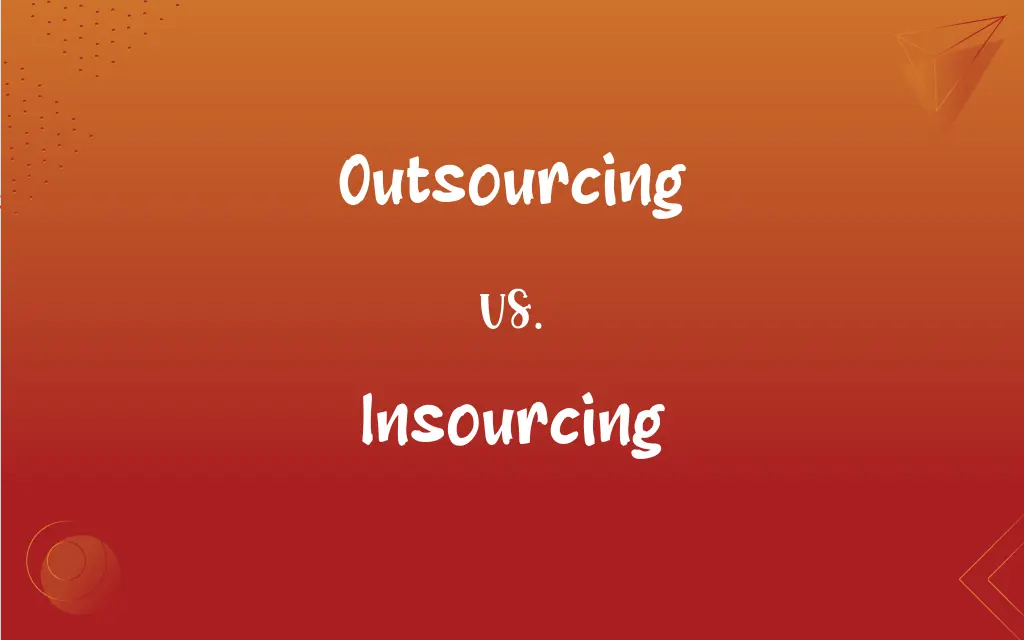Outsourcing vs. Insourcing: What's the Difference?
Edited by Aimie Carlson || By Janet White || Published on November 7, 2023
Outsourcing involves delegating tasks to external entities. Insourcing is when tasks are performed in-house, utilizing internal resources.

Key Differences
Outsourcing and insourcing are strategic decisions businesses make concerning how they manage specific tasks, operations, or services. Outsourcing involves contracting out certain jobs or functions to external service providers or third-party companies. For instance, a company might choose to outsource its customer service department to a call center located in another country. This could be due to various reasons, such as cost savings, accessing specific expertise, or focusing on core competencies. Insourcing, on the contrary, entails handling these tasks or functions internally by leveraging the company's own resources and workforce.
When a company engages in outsourcing, it taps into an outside firm's capabilities, often hoping to benefit from the third-party's experience, scale, or location advantages. Outsourcing can offer significant savings, especially if the third-party firm is located in a region with lower labor costs. Conversely, insourcing relies on the belief that the company has the skills, resources, and capability to handle the task efficiently within its existing structure. Insourcing might be chosen due to concerns about quality control, proprietary information security, or a desire for closer coordination among departments.
Another dimension to consider between outsourcing and insourcing is control and oversight. Outsourcing might lead to potential challenges in overseeing the quality and consistency of the outsourced function. Communication barriers, cultural differences, and time zone disparities can sometimes hinder seamless integration. Insourcing, being an internal process, usually allows for better alignment with the company's culture, values, and objectives, ensuring a higher degree of control and synchronization.
A significant factor driving the choice between outsourcing and insourcing is the evolving business landscape and the company's objectives at a given time. Outsourcing may start as a strategic move to cut costs, but over time, as the company grows or its objectives shift, it might consider insourcing to regain control or better integrate services. Similarly, a firm might initially handle functions internally (insourcing) but later find that outsourcing offers better scalability or specialization.
Comparison Chart
Definition
Delegating tasks to external entities
Performing tasks in-house using internal resources
ADVERTISEMENT
Control & Oversight
Might be diminished due to distance and mediation
Generally higher due to immediate oversight
Main Objective
Cost-saving, specialization, scalability
Control, integration, proprietary security
Resource Involvement
Typically involves third-party resources
Utilizes company's own resources and staff
Flexibility
Defined by contractual terms
Typically more adaptable to internal changes
Outsourcing and Insourcing Definitions
Outsourcing
Contracting out business processes to third parties.
The firm considered outsourcing its IT department to save on operational costs.
ADVERTISEMENT
Insourcing
Using internal resources to handle specific business processes.
Insourcing the marketing department led to a more cohesive brand strategy.
Outsourcing
Delegating specific tasks or services to external experts.
Outsourcing their customer support allowed the startup to focus on product development.
Insourcing
Assigning tasks to be conducted within the organization.
They decided on insourcing content creation to maintain brand voice consistency.
Outsourcing
Entrusting certain operations to entities outside the company.
Through outsourcing, the manufacturing unit was moved overseas to benefit from reduced labor costs.
Insourcing
Opting to perform functions in-house rather than contracting them out.
Insourcing customer service ensured a high-quality experience for their clients.
Outsourcing
Transferring responsibilities of certain functions to outside firms.
Outsourcing the data analysis process enabled the company to access advanced analytics expertise.
Insourcing
Managing and executing tasks using the company's own staff and resources.
Through insourcing, the tech team developed proprietary software tailored to the company's needs.
Outsourcing
Engaging external organizations to handle specific business activities.
Outsourcing payroll processing proved efficient for the company's vast employee base.
Insourcing
Relying on internal expertise and capabilities for specific operations.
They chose insourcing to protect their innovative technologies from potential competitors.
Outsourcing
To delegate (a task, function, or responsibility) to an independent provider
"Most retailers outsource the bulk of their manufacturing to Third World countries, where labor is dramatically cheaper" (James Surowiecki).
Insourcing
The obtaining of goods or services using existing in-house resources or employees.
Outsourcing
To relocate or transfer (jobs) to another labor market
"Although the absolute number of jobs outsourced from developed countries to China remains small, the threat that firms could produce offshore helps to keep a lid on wages" (The Economist).
Insourcing
The obtaining of goods or services using domestic resources or employees as opposed to foreign.
Outsourcing
Inflection of outsource
Insourcing
Present participle of insource
Outsourcing
The transfer of a business function to an external service provider.
FAQs
Does outsourcing always lead to job losses internally?
Not always. Outsourcing can free up internal resources for different roles or strategic tasks.
Is outsourcing always about cost-saving?
While a common reason, outsourcing can also be for expertise, scalability, or focusing on core competencies.
Is insourcing typically more expensive than outsourcing?
Not necessarily. Costs depend on various factors like task complexity, location, and resource availability.
Does insourcing mean not relying on any external tools or platforms?
Not necessarily. Insourcing focuses on internal resources for tasks, but can still use external tools.
Can a company engage in both outsourcing and insourcing simultaneously?
Yes, companies often mix strategies, outsourcing some functions while insourcing others.
Is insourcing always a long-term strategy?
Not necessarily. Companies might insource for specific projects or transitional periods.
What's a key risk of outsourcing?
Potential risks include quality control, data security, and dependency on third-party firms.
Can insourcing boost employee morale?
It can, as it might signal investment in internal growth and development.
How does insourcing impact internal training and development?
Insourcing often necessitates continuous training to ensure the team remains competent and efficient.
How does outsourcing impact a company's flexibility?
It can limit flexibility due to contractual terms, but can also offer scaling flexibility.
Does insourcing ensure better quality?
Not inherently. Quality depends on internal capabilities, resources, and oversight.
Does outsourcing mean a company lacks capability?
No, outsourcing can be strategic, even for capable firms, to focus on core functions or achieve other goals.
Why might a company revert from outsourcing to insourcing?
Reasons include desiring more control, protecting proprietary information, or changes in cost-benefit analysis.
Can outsourcing lead to a loss of company culture or identity?
It's possible, especially if core functions or customer-facing roles are outsourced.
Can outsourcing lead to communication challenges?
It can, especially with different time zones, cultures, or languages involved.
Can a previously outsourced function be insourced again?
Yes, businesses often reevaluate and shift between strategies based on evolving needs.
Can insourcing be a response to failed outsourcing?
Yes, if outsourcing doesn't meet expectations, companies might revert to insourcing.
How does insourcing affect direct oversight and management?
Insourcing allows for direct oversight, potentially leading to quicker decision-making and adjustments.
Are there industries where outsourcing is more prevalent?
Yes, industries like IT, customer service, and manufacturing often see higher outsourcing rates.
Can insourcing spur innovation?
It can, especially if internal teams are encouraged to innovate and have the resources to do so.
About Author
Written by
Janet WhiteJanet White has been an esteemed writer and blogger for Difference Wiki. Holding a Master's degree in Science and Medical Journalism from the prestigious Boston University, she has consistently demonstrated her expertise and passion for her field. When she's not immersed in her work, Janet relishes her time exercising, delving into a good book, and cherishing moments with friends and family.
Edited by
Aimie CarlsonAimie Carlson, holding a master's degree in English literature, is a fervent English language enthusiast. She lends her writing talents to Difference Wiki, a prominent website that specializes in comparisons, offering readers insightful analyses that both captivate and inform.






































































